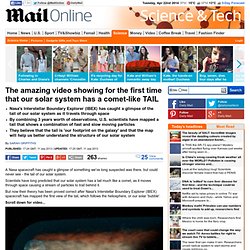

Formation and evolution of the Solar System. This widely accepted model, known as the nebular hypothesis, was first developed in the 18th century by Emanuel Swedenborg, Immanuel Kant, and Pierre-Simon Laplace. Its subsequent development has interwoven a variety of scientific disciplines including astronomy, physics, geology, and planetary science. Since the dawn of the space age in the 1950s and the discovery of extrasolar planets in the 1990s, the model has been both challenged and refined to account for new observations.
The Solar System has evolved considerably since its initial formation. Many moons have formed from circling discs of gas and dust around their parent planets, while other moons are thought to have formed independently and later been captured by their planets. Still others, as the Earth's Moon, may be the result of giant collisions. History[edit] Understanding of how the Sun will continue to evolve required an understanding of the source of its power. Formation[edit] Pre-solar nebula[edit] Formation of planets[edit] Two Good Ways to Really *Get* the Solar System. The Sun is one busy celestial body.

In addition to giving us light, holding the solar system together, and providing the energy for almost every living thing on Earth, it’s also a grapefruit in a grass field in Austin, Texas, and a 50-foot yellow archway in northern Maine. Now, obviously this huge mass of incandescent gas is not literally making a tour of some of the geographical extremes of the contiguous U.S. states. These are just two places it’s made recent honorary appearances in the name of science. The reason for these appearances is that it’s a lot harder to accurately depict the solar system than a lot of people realize. Not only are the Sun and planets enormously larger than anything we deal with on a daily basis, but the spaces between them are incredibly more vast than the bodies themselves, making even the Sun look tiny. While the two models are very different in materials and scale, one important thing they share is the element of movement. The amazing video showing for the first time that our solar system has a comet-like TAIL.
Nasa's Interstellar Boundary Explorer (IBEX) has caught a glimpse of the tail of our solar system as it travels through spaceBy combining 3 years worth of observations, U.S. scientists have mapped a tail that shows a combination of fast and slow moving particlesThey believe that the tail is 'our footprint on the galaxy' and that the map will help us better understand the structure of our solar system By Sarah Griffiths Published: 17:24 GMT, 11 July 2013 | Updated: 17:25 GMT, 11 July 2013 A Nasa spacecraft has caught a glimpse of something we've long suspected was there, but could never see - the tail of our solar system.

Scientists have long predicted that our solar system has a tail much like a comet, as it moves through space causing a stream of particles to trail behind it. But now their theory has been proved correct after Nasa's Interstellar Boundary Explorer (IBEX) spacecraft has mapped the first view of the tail, which follows the heliosphere, or our solar 'bubble'. Dave Tyler's Astrophotography Website - Images. Welcome to Views of the Solar System!
Earth. The Moon. Saturn. Jupiter. Mars. Mercury.